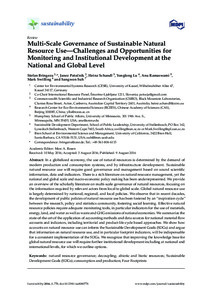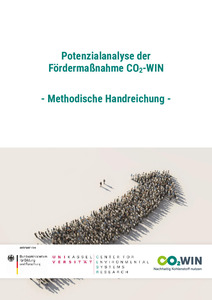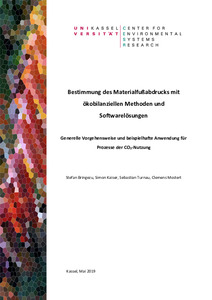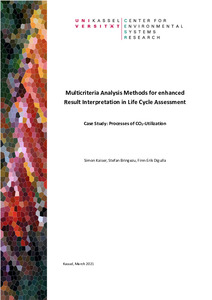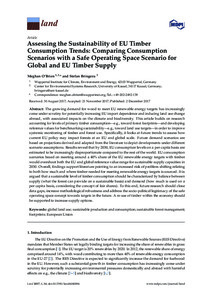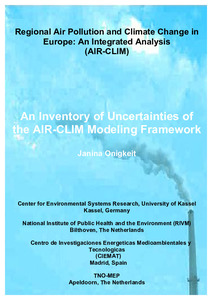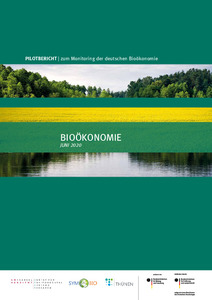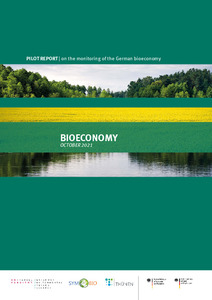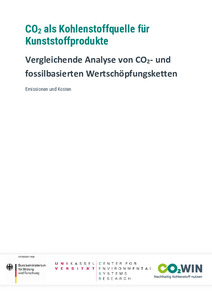Suche
Anzeige der Dokumente 1-10 von 10
Aufsatz
 Multi-Scale Governance of Sustainable Natural Resource Use—Challenges and Opportunities for Monitoring and Institutional Development at the National and Global Level
Multi-Scale Governance of Sustainable Natural Resource Use—Challenges and Opportunities for Monitoring and Institutional Development at the National and Global Level
(2016-08-09)
In a globalized economy, the use of natural resources is determined by the demand of modern production and consumption systems, and by infrastructure development. Sustainable natural resource use will require good governance and management based on sound scientific information, data and indicators. There is a rich literature on natural resource management, yet the national and global scale and macro-economic policy making has been underrepresented. We provide an overview of the scholarly literature on multi-scale ...
Working paper
 Potenzialanalyse der Fördermaßnahme CO₂-WIN
Potenzialanalyse der Fördermaßnahme CO₂-WIN
(2022-01)
Die Nutzung von CO₂ als Rohstoff ist ein vielversprechender Weg, um fossilen Kohlenstoff in verschiedensten Anwendungen zu substituieren, emittiertes CO₂ produktiv einzusetzen und Kohlenstoff vermehrt im Kreislauf zu führen. Im Rahmen der Fördermaßnahme CO₂-WIN wird deshalb in insgesamt 15 verschiedenen Forschungsprojekten untersucht, wie CO₂ als Rohstoff zur Produktion von werthaltigen Produkten eingesetzt werden kann. In diesem Dokument wird die Herangehensweise zur Analyse und Berechnung der zukünftigen Potenziale, ...
Working paper
 Bestimmung des Materialfußabdrucks mit ökobilanziellen Methoden und Softwarelösungen
Bestimmung des Materialfußabdrucks mit ökobilanziellen Methoden und Softwarelösungen
(2019-05)
Die Bestimmung des Materialfußabdrucks ist wichtig, um die Ressourcenproduktivität jedes Unternehmens und letztlich der Gesamtwirtschaft wirksam steigern zu können. Deshalb wurde eine methodische Handreichung zur Bestimmung des Materialfußabdrucks von Produkten und Infrastrukturen entwickelt und die Vorgehensweise am Beispiel der CO2-Nutzung erläutert. Der Konzepthintergrund, die Hauptindikatoren und die Verwendung von opensource Software mit einschlägigen LCA-Datenbanken werden vorgestellt.
Working paper
 Multicriteria Analysis Methods for enhanced Result Interpretation in Life Cycle Assessment
Multicriteria Analysis Methods for enhanced Result Interpretation in Life Cycle Assessment
(2021-03)
In this document the problem of trade-offs between indicators in Life Cycle Assessment (LCA) studies is explained in more detail as well as the requirement of MCA methods to accommodate them. Furthermore, the four environmental footprints in combinations with certain other indicators are proposed as a common minimum-set of indicators to harmonize LCA-studies and to ensure their comparability. Important rules for the conduction of an LCA for CO2 utilization technologies are also explained. In the next step, methods ...
Diverses
 Zukünftige Nutzung von CO2 als Rohstoffbasis der deutschen Chemie- und Kunststoffindustrie
Zukünftige Nutzung von CO2 als Rohstoffbasis der deutschen Chemie- und Kunststoffindustrie
(2020-03)
In der Roadmap werden Möglichkeiten der Nutzung von CO2 als Rohstoff in der deutschen Chemie- und Kunststoffindustrie analysiert. Bislang verläuft der Fluss von Kohlenstoff von der Extraktion der fossilen Rohstoffe Erdöl und Erdgas über die Verarbeitung und die Nutzung in Form von Kunststoffen bis zur Entsorgung hauptsächlich linear. Die Analyse zeigt wie mit Hilfe von CO2-Nutzungstechnologien bis zum Jahr 2050 ein geschlossener Kohlenstoffkreislauf erreicht werden könnte. Die verfügbaren Technologien werden ...
Aufsatz
 Assessing the Sustainability of EU Timber Consumption Trends: Comparing Consumption Scenarios with a Safe Operating Space Scenario for Global and EU Timber Supply
Assessing the Sustainability of EU Timber Consumption Trends: Comparing Consumption Scenarios with a Safe Operating Space Scenario for Global and EU Timber Supply
(2017-12-02)
The growing demand for wood to meet EU renewable energy targets has increasingly come under scrutiny for potentially increasing EU import dependence and inducing land use change abroad, with associated impacts on the climate and biodiversity. This article builds on research accounting for levels of primary timber consumption—e.g., toward forest footprints—and developing reference values for benchmarking sustainability—e.g., toward land use targets—in order to improve systemic monitoring of timber and forest use. ...
Technischer Report
 An inventory of uncertainties of the AIR-CLIM modeling framework
An inventory of uncertainties of the AIR-CLIM modeling framework
(Center for Environmental Systems Research, University of Kassel, 2001)
Technischer Report
 Pilotbericht zum Monitoring der deutschen Bioökonomie
Pilotbericht zum Monitoring der deutschen Bioökonomie
(2020-06)
Der Pilotbericht analysiert wesentliche Merkmale und Trends der deutschen „biobasierten Ökonomie“, um die aktuellen Probleme, die Zukunftschancen und die Bedingungen für eine nachhaltige Bioökonomie aufzuzeigen. Um dies zu beurteilen, werden auch die globalen Auswirkungen der deutschen Bioökonomie betrachtet.
Mit den Kapiteln biogene Stoffströme in Deutschland (Kap. 2), Sozioökonomische Entwicklung der Bioökonomie (Kap. 3), Entwicklung von Trends und Treibern der Bioökonomie (Kap. 4) und die ökologischen Fußabdrücke ...
Technischer Report

 Pilot report on the monitoring of the German bioeconomy
Pilot report on the monitoring of the German bioeconomy
(2021-10)
This report assesses the main characteristics and trends of the German ‘bio-based economy’ in order to identify current problems, future chances and the needs for a sustainable bioeconomy. It includes global impacts of the German bioeconomy transition.
A wide perspective is provided through the chapters: Biogenic material flows in Germany (Ch. 2); Socio-economic development of the bioeconomy in Germany (Ch. 3); Development of the trends and drivers of the bioeconomy Ch. 4); The environmental footprints of the German ...
Working paper
 CO₂ als Kohlenstoffquelle für Kunststoffprodukte
CO₂ als Kohlenstoffquelle für Kunststoffprodukte
(2024-03)
Die Nutzung von Kohlenstoff stellt eine wichtige Materialbasis der Chemie- und Kunststoffindustrie dar, weil dieser für die Produktion von organischen Chemikalien, Kunststoffen und darauf basierender Produkte unabdingbar ist. Als Kohlenstoffquellen werden aktuell größtenteils fossile Rohstoffe verwendet. Gleichzeitig werden kohlenstoffhaltige Produkte hauptsächlich linear genutzt, wodurch der Kohlenstoff am Ende des Lebenszyklus in Form von CO₂ in die Atmosphäre emittiert wird, anstatt ihn zu recyclen. In der deutschen ...

